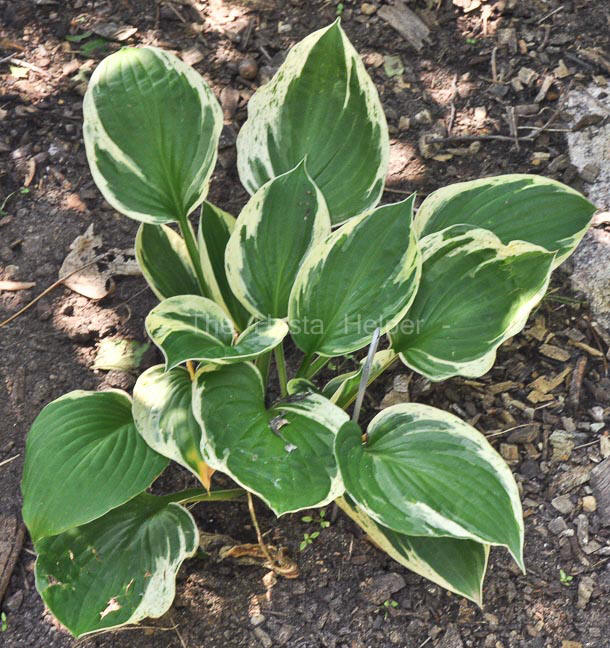|
  A 2001 Walters Gardens, Inc.
of Michigan registration, this cultivar
was discovered by
Jeff A. Westendrop as a tissue culture sport of H. 'Revolution'.
It was patented in the U.S. in 2006. The hosta
forms a medium size plant about 18 inches high and 43 inches
wide. Funnel shaped, lavender flowers bloom from mid-July into August. A 2001 Walters Gardens, Inc.
of Michigan registration, this cultivar
was discovered by
Jeff A. Westendrop as a tissue culture sport of H. 'Revolution'.
It was patented in the U.S. in 2006. The hosta
forms a medium size plant about 18 inches high and 43 inches
wide. Funnel shaped, lavender flowers bloom from mid-July into August.
According to
The Hostapedia by Mark Zilis (2009), "...the "reversed sport" of
'Revolution'..."
The New Encyclopedia of Hostas by
Diana
Grenfell (2009) states: "Moderate growth rate...Superb in containers...Very
conspicuous green flecking in the marginal variegation."

An article by Warren I. Pollock in
The
Hosta Journal (2008 Vol. 39 No. 2) states that, "Paul
Aden in The Hosta Book mentioned that medio-variegated hostas develop
plain-leaved forms more readily than margin-variegated hostas. My observations
are that 'Revolution'
 develops all-green leaves more readily than
'Independence'
does. Apparently this is to be expected because 'Revolution' has more white
tissue than 'Independence' -- and it's white tissue that wants to "re-green"." develops all-green leaves more readily than
'Independence'
does. Apparently this is to be expected because 'Revolution' has more white
tissue than 'Independence' -- and it's white tissue that wants to "re-green"."
An article by Warren I. Pollock in
The
Hosta Journal (2015 Vol. 46 No.2) states that, "During
the 50 or so years that 'Francee', a diploid...has been cultivated, some 75
sport descendents have been reported. About 20 are diploid and for the most part
of lesser interest...the tetraploid sports...have been of principal attention.
Examples are first generation H. 'Patriot' that sported...H. 'Loyalist' that
sported...H. 'Revolution that sported...H.
'Independence'...H. 'Minuteman' and H.
'Pathfinder'...sported several tetraploid second generations of commercial
interest."

|
 |
|
 United
States Patent: PP17044 (2006) United
States Patent: PP17044 (2006)
Abstract: A new and distinct Hosta plant named
‘Independence’ characterized by very thick substance in
the leaves, deep green coloring, upright habit in youth,
lavender flowers held nicely above foliage, wide
creamy-white margin, and the margin containing numerous
small green flecks suitable for landscape, potted
culture, or cut flower arrangements.
 |






|



